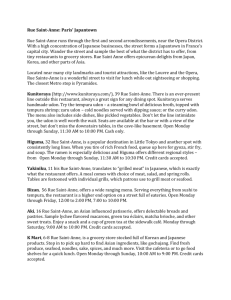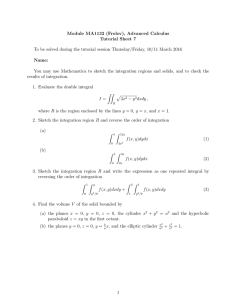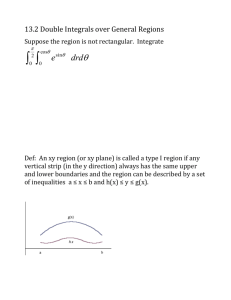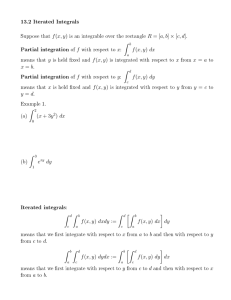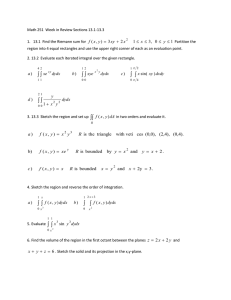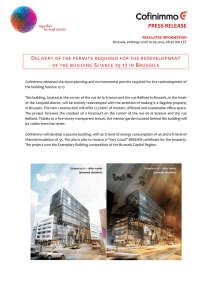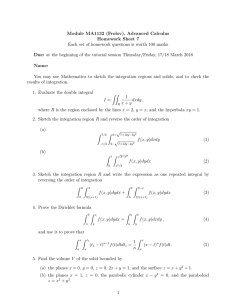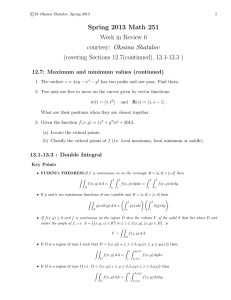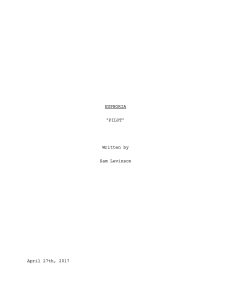14.30 EXAM 1 - SUGGESTED ANSWERS Question 1 A. (i)
advertisement
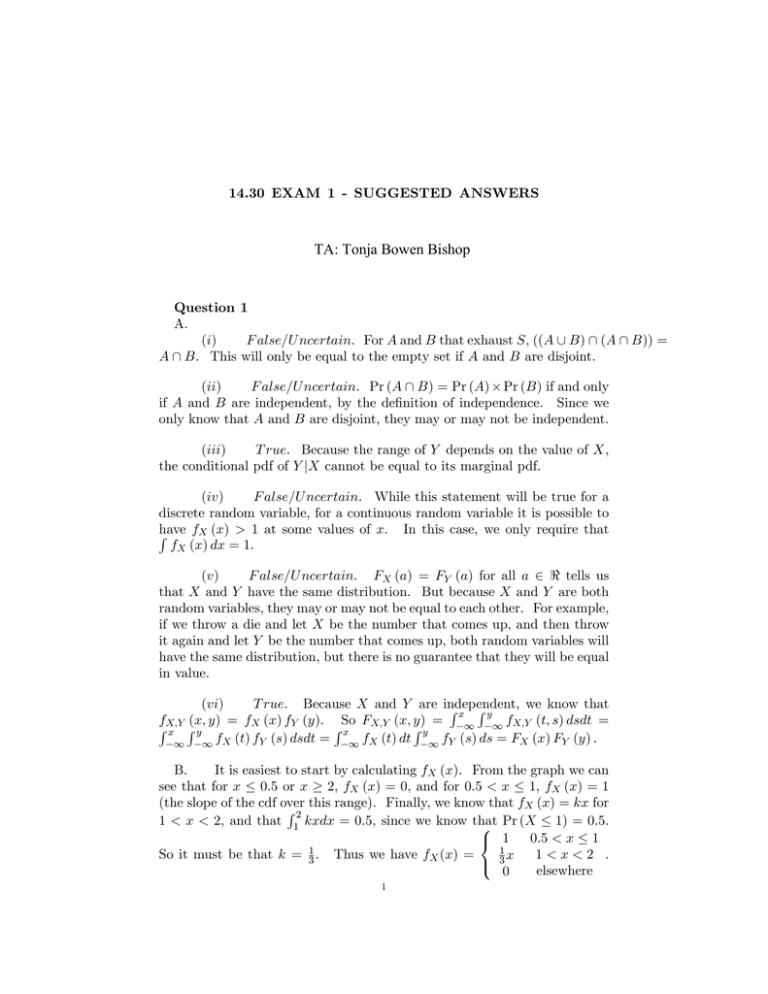
14.30 EXAM 1 - SUGGESTED ANSWERS TA: Tonja Bowen Bishop Question 1 A. (i) F alse=U ncertain. For A and B that exhaust S, ((A [ B) \ (A \ B)) = A \ B. This will only be equal to the empty set if A and B are disjoint. (ii) F alse=U ncertain. Pr (A \ B) = Pr (A) Pr (B) if and only if A and B are independent, by the de…nition of independence. Since we only know that A and B are disjoint, they may or may not be independent. (iii) T rue. Because the range of Y depends on the value of X, the conditional pdf of Y jX cannot be equal to its marginal pdf. (iv) F alse=U ncertain. While this statement will be true for a discrete random variable, for a continuous random variable it is possible to have fX (x) > 1 at some values of x. In this case, we only require that R fX (x) dx = 1. (v) F alse=U ncertain. FX (a) = FY (a) for all a 2 < tells us that X and Y have the same distribution. But because X and Y are both random variables, they may or may not be equal to each other. For example, if we throw a die and let X be the number that comes up, and then throw it again and let Y be the number that comes up, both random variables will have the same distribution, but there is no guarantee that they will be equal in value. (vi) T rue. Because X and Y are independent, we know that Rx Ry fX;Y (x; y) = fX (x) fY (y). So FX;Y (x; y) = f (t; s) dsdt = X;Y 1 1 Rx Ry Rx Ry 1 1 fX (t) fY (s) dsdt = 1 fX (t) dt 1 fY (s) ds = FX (x) FY (y) : B. It is easiest to start by calculating fX (x). From the graph we can see that for x 0:5 or x 2, fX (x) = 0, and for 0:5 < x 1, fX (x) = 1 (the slope of the cdf over this range). Finally, we know that fX (x) = kx for R2 1 < x < 2, and that 1 kxdx = 0:5, since we know that 8 Pr (X 1) = 0:5. 0:5 < x 1 < 1 1 1 1<x<2 . So it must be that k = 3 . Thus we have fX (x) = x : 3 elsewhere 0 1 2 14.30 EXAM 1 - SUGGESTED ANSWERS 8 0 x 0:5 > > < x 1 0:5 <x 1 22 . Note that Then we can integrate to …nd FX (x) = x 1 1<x<2 > > 3+ 6 : X 2 1 in general, we cannot determine whether or not the inequalities are strict. For the graph, see the attached …gure. Question 2 (i) We multiply together the number of ways the students from each 30 36 school can be selected: 15 3 2 3 : (ii) Now we ignore the information on school a¢ liation. We have 81 students, of whom 35 are women. So there are 81 8 possible ways to choose 46 35 the committee, and 6 2 ways to select a committee with exactly two women. So we have Pr (2 women) = 46 6 35 2 81 8 30 36 (iii) We can select the …rst group in 15 5 10 12 ways, and conditional 20 24 on that selection, there are 10 to choose the second group, and then 5 10 12 all remaining students are in the third group. However, we must be careful to avoid multiple counting of divisions that put the same students together into di¤erently ordered groups (i.e. putting a set X of students in group 1, a set Y in group 2, and a set Z in group 3 vs. putting X in group 2, Y in group 3, and Z in group 1), since the wording of the question does not suggest that we should care about the ordering of the groups. So the total number of di¤erent ways we can separate the students into three groups is 15 5 30 10 36 12 10 5 20 10 24 12 3! Question 3 (i) If the claim is true, we can think about the test as a binominal experiment, where X is the number of students out of 20 that improve their score on the second test (each student is a stage). We want to …gure the probability that exactly 16 of 20 improve their scores, given that for each person, the probability of improvement is equal and independent of the improvement of other students. What is this probability? The score could improve for one of two reasons: either the pill was e¤ective for that person, or the pill was not e¤ective, and the person just happened to do better on the second test. So the probability of an improved test score when the claimis true is (0:8) + (0:2) (0:5) = 0:9 20 (0:9)16 (0:1)4 16 t 0:08978 Pr (X = 16jT rue) = 14.30 EXAM 1 - SUGGESTED ANSWERS 3 (ii) We have the same setup, but now an improvement in test scores only occurs randomly. Thus the probability of improvement is 0.5, and so we have 20 (0:5)16 (0:5)4 16 t 0:00462 Pr (X = 16jN ot T rue) = (iii) Now we will use Bayes rule to …nd Pr (T ruejX = 16): Pr (X = 16jT rue) Pr (T rue) Pr (X = 16jT rue) Pr (T rue) + Pr (X = 16jN ot T rue) Pr (N ot T rue) Pr (T ruejX = 16) = 20 16 = (0:9)16 (0:1)4 (0:9)16 (0:1)4 20 16 1 2 4 + 20 16 1 2 (0:5)16 (0:5)4 1 2 (0:9)16 (0:1) (0:9)16 (0:1)4 + (0:5)16 (0:5)4 t 0:95105 = (iv) For this question, we use the law of total probability based on Dr. Testing’s new belief about the veracity of the …rm’s claim. Note that we are now interested in the probability that the student’s math ability will actually improve, rather than just her test score. Pr (improve) = Pr (improvejT rue) Pr (T rue) + Pr (improvejN ot T rue) Pr (N ot T rue) t (0:8) (0:95105) + (0) (1 0:95105) t 0:76084 Question 4 (i) We …nd k by setting the integral over the space of possible (x; y) values equal to one and solving: Z 40 Z 40 k x2 + xy dydx = 1 10 10 Z 40 Z 40 k x (x + y) dy dx = 1 10 k Z 10 40 30x2 + 750x dx = 1 10 k (1192500) = 1 k t 8:39 10 7 4 14.30 EXAM 1 - SUGGESTED ANSWERS (ii) We want to …nd the probability that both x and y are between 20 and 30 psi. So we just need to integrate over this range. Z 30 Z 30 x2 + xy dydx Pr (X; Y 2 (20; 30)) = k 20 20 (iii) Now we want the probability that X > Y , and again, we integrate over the relevant range within the sample space. Z 40 Z x Pr (X > Y ) = k x2 + xy dydx 10 Or, equivalently Pr (X > Y ) = k Z 40 Z 40 x2 + xy dxdy y 10 (iv) 10 We …rst …nd the marginal distribution of X. Z 40 fX;Y (x; y) dy fX (x) = 10 Z 40 = kx (x + y) dy 10 = k 30x2 + 750x Next, to …nd the conditional distribution of XjY , we will need the marginal distribution of Y . Z 40 fY (y) = fX;Y (x; y) dx 10 Z 40 = k x2 + xy dx 10 = k (21000 + 750y) Now, the conditional distribution. fX;Y (x; y) fY (y) k x2 + xy = k (21000 + 750y) x2 + xy = 21000 + 750y Thus, knowing the pressure in the left tire will change our assessment of the probability distribution of the pressure in the right tire. In other words, X and Y are not independent. fXjY (xjy) = (v) We need to integrate over the area within the sample space that satis…es both X + Y 40 and jX Y j 1, or in other words, we are 14.30 EXAM 1 - SUGGESTED ANSWERS 5 interested in the area bounded by the lines y = x + 1, y = x 1, y = 40 x, y = 10, and x = 10, as shown in the attached …gure. We will need to divide the area into three parts, and to do so, we need to …nd the coordinates of the points where various lines intersect. Point (a) is then intersection of the lines y = x 1 and y = 10, so the coordinates of point (a) are (11; 10). Similarly, point (b) is the intersection of the lines y = x + 1 and x = 10, so it has coordinates (10; 11). Point (c) is the intersection of y = x + 1 and y = 40 x, so it’s coordinates are (19:5; 20:5), and point (d) is the intersection of y = x 1 and y = 40 x at (20:5; 19:5). Now, the probability can be calculated by dividing the area of interest with veritcal lines at x = 11 and x = 19:5, as follows: Z 11 Z x+1 Pr ((X + Y 40) \ (jX Y j 1)) = k x2 + xy dydx + 10 10 Z 19:5 Z x+1 k x2 + xy dydx + 11 x 1 20:5 Z 40 x k x2 + xy dydx 11 y 1 20:5 Z 40 y k x2 + xy dxdy Z 19:5 x 1 Or, alternatively, we can separate with horizontal lines at y = 11 and y = 19:5: Z 11 Z y+1 k x2 + xy dxdy + Pr ((X + Y 40) \ (jX Y j 1)) = 10 10 Z 19:5 Z y+1 k x2 + xy dxdy + Z 19:5 y 1
